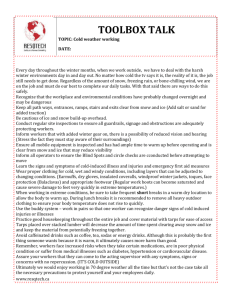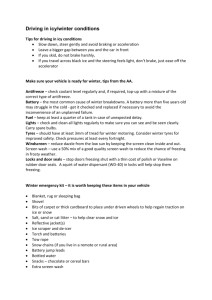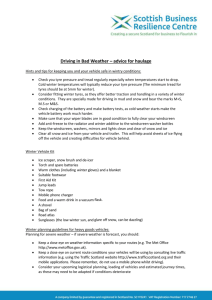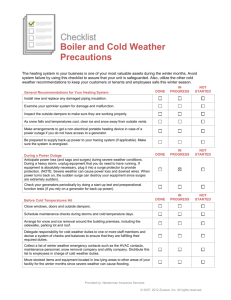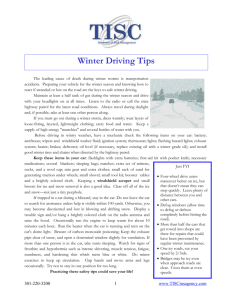D_Winter_driving
advertisement
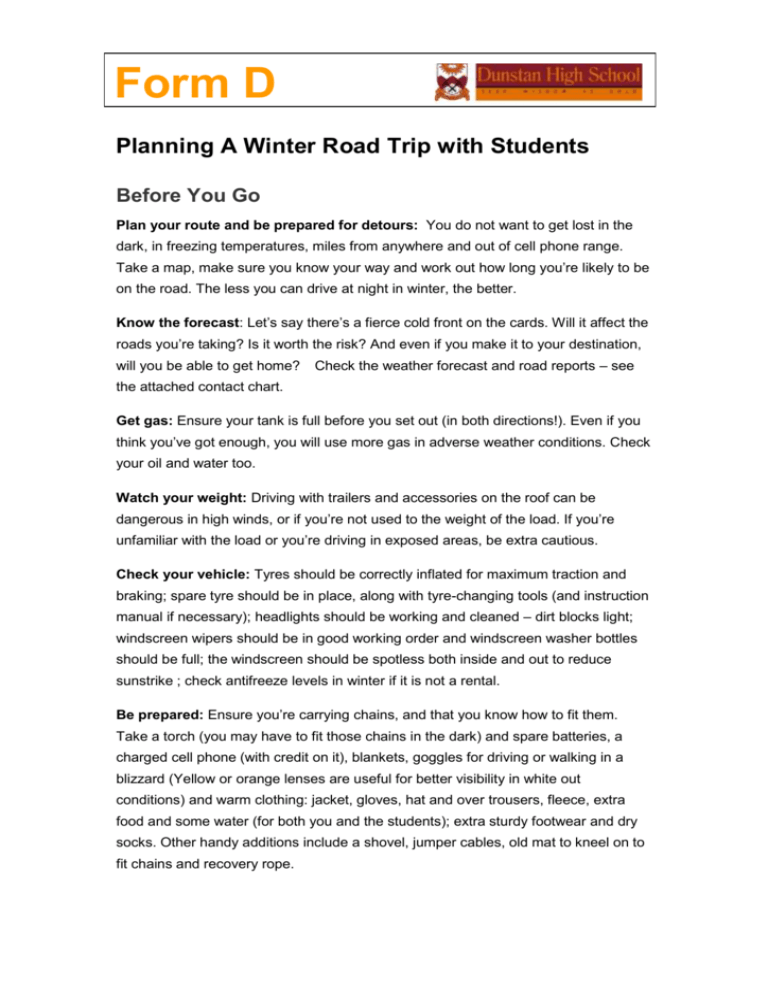
Form D Planning A Winter Road Trip with Students Before You Go Plan your route and be prepared for detours: You do not want to get lost in the dark, in freezing temperatures, miles from anywhere and out of cell phone range. Take a map, make sure you know your way and work out how long you’re likely to be on the road. The less you can drive at night in winter, the better. Know the forecast: Let’s say there’s a fierce cold front on the cards. Will it affect the roads you’re taking? Is it worth the risk? And even if you make it to your destination, will you be able to get home? Check the weather forecast and road reports – see the attached contact chart. Get gas: Ensure your tank is full before you set out (in both directions!). Even if you think you’ve got enough, you will use more gas in adverse weather conditions. Check your oil and water too. Watch your weight: Driving with trailers and accessories on the roof can be dangerous in high winds, or if you’re not used to the weight of the load. If you’re unfamiliar with the load or you’re driving in exposed areas, be extra cautious. Check your vehicle: Tyres should be correctly inflated for maximum traction and braking; spare tyre should be in place, along with tyre-changing tools (and instruction manual if necessary); headlights should be working and cleaned – dirt blocks light; windscreen wipers should be in good working order and windscreen washer bottles should be full; the windscreen should be spotless both inside and out to reduce sunstrike ; check antifreeze levels in winter if it is not a rental. Be prepared: Ensure you’re carrying chains, and that you know how to fit them. Take a torch (you may have to fit those chains in the dark) and spare batteries, a charged cell phone (with credit on it), blankets, goggles for driving or walking in a blizzard (Yellow or orange lenses are useful for better visibility in white out conditions) and warm clothing: jacket, gloves, hat and over trousers, fleece, extra food and some water (for both you and the students); extra sturdy footwear and dry socks. Other handy additions include a shovel, jumper cables, old mat to kneel on to fit chains and recovery rope. On the Road Conditions: Make sure that you are comfortable with driving in the conditions that are likely to be encountered, i.e. mud, ice, snow and loose gravel. If not have back up accommodation options in your risk management thinking. Be patient! Winter conditions dictate slower travel. Chances are you may end up behind a slow driver who’s not comfortable with the conditions. Be patient; only overtake if you’re confident about the road conditions ahead and travel at a much larger distance behind the other vehicle than you usually would. On average, the ‘two-second rule’ becomes the ‘four-second rule’. Be alert. There are many more hazards on the roads during winter – ice, snow, storms, and other drivers… Pay careful attention to what is happening around and ahead of you. Remember that innovations like 4WD, ABS and ESP are only there to aid in accident avoidance – they cannot override making bad decisions. Be visible. Driving with your headlights on low beam during winter is good practice, particularly in wet, snowy or foggy conditions as well as at dawn and dusk. If nothing else, they alert other drivers to your presence. And finally… Safety (and Knowledge) in numbers. Traveling with companions is always a good idea in winter. The combined knowledge and experience of a group may outweigh that of an individual. 24 Hour Breakdown Services AA: 0800 224 357 Driving in winter - some tips from the ski fields Make sure that you are comfortable with driving in the conditions that are likely to be encountered, i.e. mud, ice, snow and loose gravel Driving Guidelines The rule of thumb is that downhill traffic gives way. Drive to be able to stop. Prepare to stop before you need to. Don’t use brakes on the icy bits – if you have to stop or slow down, brake before you need to on a piece of road that has dirt, grit or a roughened surface. Assess the conditions for yourself. Put on chains if in doubt. Use the gears to brake. Stay in first or second in icy conditions downhill Keep your speed down at all times to be prepared for the unexpected. Always fully clear windscreens of any ice or misting to ensure good vision Leave your vehicle in gear with the handbrake off when parked in cold conditions on the flat On overnights, lift your windscreen wipers clear of the front window Driving conditions ICE Black ice is the most dangerous. Always be prepared as black ice is usually not visible and can be encountered in shaded spots especially after rain. Roads can be come icy as a grader clears the snow, so be aware that following a grader may result in the road becoming icier. There is sometimes a band of ice for 200-300 vertical meters when it has rained overnight and the lower section is wet and top section is snow. You can come across this by surprise and it needs particular care as well as chains. MUD Mud is not difficult to drive but needs extra care during descents and on corners. Ruts will throw you around but are not as potentially dangerous as black ice. Try to stay out of the ruts if possible. GRAVEL Loose gravel can cause unexpected sliding and can be dangerous. SNOW Snow can be deceptive. At lower altitudes it can be soft so beware of changes as you progress to higher altitudes. Be wary that there is not ice under the snow especially at lower altitudes after a snowfall that started with rain during the day and turned to snow as the temperature dropped. Attempt to drive in the roughened areas where you can see grit, dirt or gravel. It is better for traction than where everyone else drives except when the vehicles in front have been using chains. If you need to slow down prepare in advance by choosing a roughened area. FALSE EDGES Often after snow, when the roads have been graded, the road edges can have a flat appearance which can hide soft snow on the outside edges and soft snow over ditches on the inside edge. It is very easy for this snow to “grab” a wheel and pull the vehicle off to the side or for the edge to collapse. FOG Fog creates difficulty in finding the road. Good goggles / sunglasses are essential. Keep fresh warm air coming on the windscreen to prevent the build up of mist. BLIZZARD Blizzard conditions are very difficult. Do not continue unless you can see the road ahead, pull off the road and wait for help or phone for help.
